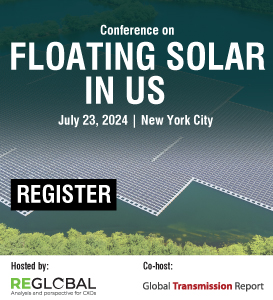Big Moves
Eversource Energy to sell Sunrise Wind stake to Ørsted
Eversource Energy has completed the necessary paperwork for its previously disclosed deal to sell its 50 per cent share in the 924 MW Sunrise Wind project to Ørsted. Despite the sale, Eversource will continue to oversee the onshore construction of the Sunrise Wind project through a separate construction management agreement.
News
Vattenfall, BASF ink purchase agreement for 49 per cent of Nordlicht offshore wind farms
Vattenfall and BASF have concluded the sale of 49 percent of Vattenfall's Nordlicht 1 and 2 wind farms to BASF. The Nordlicht wind project is being constructed in the German North Sea without state subsidies. Vattenfall is developing and constructing the Nordlicht sites
Interviews
The IRA is a historic legislation within the US and globally: Laura Lochman
We are now 18 months into the implementation of the IRA. We are able to assess it with more granularity now and observe how it is actually being implemented. Approximately 210,000 jobs have been created as a result of the IRA and the activities associated with it. We have also seen the announcement of investments exceeding $220 billion. There cannot be an energy transition without critical mineral inputs, and thus, it is a point of focus for us and for our partners and allies as well. We are planning to diversify the supply chains for clean energy technologies and critical minerals.
Opinion & Perspective
Greening the Public Estate in the UK
The annual running costs of the UK’s £188.2 billion (USD equivalent, $257.1 billion) estate is £22 billion. The most recent report on the State of the Estate (2021-22), an annual publication since 2011, shows that emissions of the estate fell by 35% over five years. Making the UK’s public capital stock climate neutral requires improving operational efficiency but crucially hinges upon upgrading public buildings, energy and transport infrastructure. What can less developed countries learn from the UK’s experience when greening their estate?
Mega Trends & Analysis
Wind Power Outlook for Brazil and US
2023 was a pivotal year for the renewables industry in Brazil, characterised by the resumption of post-pandemic activities, a new national government and acceleration of offshore wind planning. However, it also presented significant challenges. Due to the IRA, power market consultants now expect 408 GW of utility wind, solar and storage to be built in the US over the next 7 years, compared to the expected 390 GW in February 2023. Breaking this figure down, onshore wind represents 23% of the market, growing from 7.5 GW in 2024 to 16 GW in 2030 and offshore wind expectations are approximately 14 GW by 2030.
Policy Watch
EV Policies in ASEAN Countries
This provides an overview of electric vehicle (EV) policies in selected Association of Southeast Asian Nations (ASEAN) countries. It investigates the EV policies and targets, the current status of EV introduction, EV reuse plans, and battery reuse policies. While EVs have gained traction in many countries due to policy support, few nations have a long road ahead to scale up EV adoption.
Tech Talk
Recent advancements in storage technologies
Currently, the focus is on enhancing energy storage capacities to ensure reliable and cost-effective power system operations. Key trends in ESS include the shift from conventional lithium-ion (Li-ion) batteries to innovative chemicals offering improved stability, density and longevity. There is also a focus on developing solutions that store renewable energy from large-scale projects. Meanwhile, a transition towards more flexible and portable distributed ESS is being witnessed. ESS technologies encompass a range of methods for capturing, storing and releasing energy to meet demand when needed.
SPONSORED CONTENT & ADS
USE THIS SPACE
This space is reserved for sponsored content and advertising banners. Sponsored content can include white papers, webinars, case studies, research reports and other relevant content. The advertising can be in the form of banners with links to the advertiser’s landing page. If you would like to promote sponsored content or advertise, please write to us at: marketing@reglobal.co
Webinars & Videos
Critical Materials for Scaling Up Hydrogen
Hydrogen is expected to grow sevenfold to support the global energy transition, eventually accounting for 10 percent of total energy by 2050. A scale-up of this magnitude will affect demand for critical materials, including minerals and metals, needed for hydrogen technologies— electrolyzers for renewable hydrogen, carbon storage for clean hydrogen, or fuel cells using hydrogen to power transport.
Knowledge Centre
Solar and Wind Energy Mapping for Ukraine: Report
A secure supply with heat and electricity became a major challenge to many households in Ukraine as Russia systematically attacks critical infrastructure. This dire situation puts an immediate increase of the country’s energy resilience to the forefront of the political agenda. Given Ukraine’s outstanding size and land area, the country has the potential not only to be self-sufficient in energy supply, but it can also become a bigger exporter of green electricity and hydrogen.
Finance
U.S. Renewable Energy M&A: Review of 2023 and Outlook for 2024
Entering 2023, renewable energy mergers and acquisitions (“M&A”) faced significant headwinds, including sustained high interest rates, inflationary pressures, supply chain constraints, government support program uncertainty and grid reliability. As a result, renewable energy deal volume declined significantly in 2023 from 2022 levels. Despite these challenges, investor optimism grew during the back half of the year with easing supply chain bottlenecks and legislative clarity on the $369 billion energy and climate spending earmarked by the Inflation Reduction Act (“IRA”).
SPONSORED CONTENT & ADS
USE THIS SPACE
This space is reserved for sponsored content and advertising banners. Sponsored content can include white papers, webinars, case studies, research reports and other relevant content. The advertising can be in the form of banners with links to the advertiser’s landing page. If you would like to promote sponsored content or advertise, please write to us at: marketing@reglobal.co












